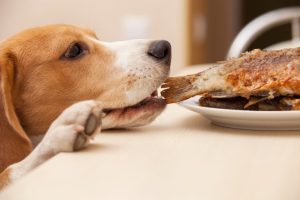Posts Tagged ‘puppy diarrhea’
The Trouble With Table Scraps
 If the holidays are at your place like it is at our place, it is family, food and football—not necessarily in any order. Unfortunately many pet owners think that holiday time means giving their pets a taste of the tender morsels that they partake in. Before you give table scraps – STOP and think a minute. These high-fat type of foods or foods that your pet is not accustom to can lead to disaster if given to our pets. Just a small amount can lead to pancreatitis in our pets, which can lead to terrible consequences.
If the holidays are at your place like it is at our place, it is family, food and football—not necessarily in any order. Unfortunately many pet owners think that holiday time means giving their pets a taste of the tender morsels that they partake in. Before you give table scraps – STOP and think a minute. These high-fat type of foods or foods that your pet is not accustom to can lead to disaster if given to our pets. Just a small amount can lead to pancreatitis in our pets, which can lead to terrible consequences.
If your pet develops pancreatitis, the treatment focuses on supportive care, such as controlling nausea and vomiting, preventing further dehydration or imbalances in the blood and feeding a low-fat nutritious diet. Serious cases may mean hospitalizing your pet for a few days or longer. Unfortunately, many other diseases have these clinical signs and it makes it a challenge determining if your pet has pancreatitis.
Early diagnosis and treatment is the key to preventing other complications such as dehydration and other systemic diseases.
As your pet ages, he can develop intolerances to certain foods so it may be best to just feed high quality pet foods with little variance and only allow healthy pet treats in moderation.
Most owners know that a only a good quality diet is necessary for their pet, however sometimes good intention visiting guests can complicate things by letting them finish their plate or giving them all of the trimmings off the turkey because they couldn’t resist.
This kind gesture could lead to the previous mentioned consequences.
To avoid pancreatitis a pet owner may take precautions to prevent it. This may include:
- Ask guests to not feed your pet table scraps
- Have healthy treats present if your guests can’t resist
- Keep pets out of the garbage
- Place your pet in a quiet room during mealtime or feed it prior to you and your guests eating
Holidays are all about celebrating and pets are a big part of our family. Kind gestures like feeding table scraps can put a damper on the celebrating if it involves an emergency trip to your veterinarian. So if you set ground rules and make your guests aware of the restrictions for your pets, we can have a safe and happy holiday season.
Olsen Veterinary Clinic is committed to the health and happiness of your pet. For questions, or to schedule an appointment, contact us here.
Parvovirus 101
Parvovirus is a highly contagious virus that is of particular concern to puppy owners due to the severity of the symptoms, the weak immune system and possible death of the puppy. The virus manifests itself in two forms. The most common form is the intestinal form, which is characterized by vomiting, diarrhea, weight loss, lethargy and lack of appetite. The less common form is the cardiac form, which attacks the heart muscles of very young puppies, often leading to death.
The intestinal form of the virus is passed through oral contact both directly and indirecty with the virus. Clinical signs will show most commonly about 5 to 10 days after exposure. It can also be spread through fomites, feces, or through infected soil and once an uninfected dog comes in to oral contact with the infection, the virus can spread quickly through the lymphoid tissue in the dog’s throat. After replication the virus will then spread to the bloodstream where it attacks cells in the bone marrow, lymph nodes, and intestines. Parvovirus then destroys those fast growing cells, depleting the body of the white blood cells and the lymphocytes, along with destroying the cells in the intestines. Puppies can then become toxic and septicemic due to the poisoning of the blood system from the virus. The puppy has the inability to absorb nutrients and will become dehydrated and weak quickly from lack of protein and fluid absorption. The puppy’s abdomen may become painful on palpation and the heart may beat rapidly.
The cardiac form seen in puppies is usually fatal. It is less common and is usually spread to the puppy in utero or when the mother is pregnant with them. The virus damages the heart muscle which aren’t strong enough to withstand the virus. The death of the puppies with this form usually come on suddenly and the puppy shows little sign of distress.
Parvo is usually a disease of young puppies from four weeks to six months of age or in the older immunosuppressed dog. Time is one of the most significant factors in whether or not a treatment of parvo will be successful: thr earlier the virus is detected and the treatment begins, the better the outlook for treatment. If the virus is caught quickly enough, treatment can begin and death can be prevented. So if your pet has any of those symptoms, it is best to seek veterinary care immediately. The mortality rate is around 91% if left untreated, but with treatment mortality rates drop to 5% to 20% when treated aggressively. When presented with a possible parvo puppy, most veterinarian’s protocols will include a thorough physical examination, necessary blood work such as a complete blood count and chemistry and either an EIA or hemagglutination test on a feces sample to look for signs of parvovirus.
A puppy should always be hospitalized in order to receive treatment. Treatment usually consists of administration of IV fluids and colloids, administration of anti-nausea medications and injections of antibiotics depending upon the dog and the veterinarian administering the treatment. The administration of the fluids serve as both to rehydrate and rebalance the levels of the electrolytes to maintain healthy functions. Sometimes blood plasma transfusions may be needed to provide passive immunity to the sick individual with developed antibodies. After the initial treatment, the puppy will be weaned off additional fluids once they are able to keep fluids down. Bland foods that are easy on the gastrointestinal system is usually recommended along with oral antibiotics to help fight potential for infection due to the low white blood cell counts. Any infections following the treatment of parvovirus can lead to death because of the weakened immune system.
Because parvo can be a devastating virus, one of the most significant things any dog owner can do is prevent infection of their dog. The first step in preventing it is to properly have their puppy vaccinated based on the recommendation of their veterinarian. Most puppies derive immunity through their mother’s colostral antibodies that they receive with the first milk that they get after birth. Because of this, here at the Olsen Veterinary Clinic, we recommend starting a vaccination schedule at 6 to 8 weeks of age and then vaccinate every 3 to 4 weeks until the puppy is 16 weeks old. Our recommendation is not the number of vaccinations that it gets, but when they get them at their chronological age.
To prevent the spread of the parvovirus, it is important to decontaminate where your puppy has been. It is also important to realize that even though your puppy survived the treatment, it can still contaminate other healthy dogs with the virus through their feces. The parvovirus can survive living in the soil for as long as a year so it is crucial to decontaminate completely areas where and infected or successfully treated dog eliminates its waste. The only chemical known to kill parvo is bleach at a 15:1 ratio. The general advice is to wait about 6 months before bringing a new puppy home. It is also advised to have the puppy completely vaccinated before bringing them in to a home that has been recently exposed to the parvovirus.
The old adage of “happy neighbors are good neighbors” applies here. An important step is to notify your neighbors and friends if they have been in contact with your premises or pet. Since parvo can be spread from dog to dog in addition to being spread through feces and soil, it is important that your neighbors know. They may simply expose their pet to parvo by simply walking their puppy on your grass or even by walking across your yard and then taking it home. It is important to share the information that you have learned with your neighbors because if they see similar clinical signs and symptoms, they can act on it promptly.
Parvovirus is a very destructive and very rapidly moving disease that can kill an otherwise healthy puppy in a matter of days, but with proper precautions it can possibly be wiped out. All it takes is regular vaccinations of all dogs in addition to treatment and appropriate decontamination of infected areas. Even if a dog is successfully treated and recovers from parvo without proper decontamination of the home area, it is possible to spread the disease to other dogs in the community. It takes a combinations of responsible pet ownership, good veterinary care, and vigilant decontamination of infected areas in order to prevent and hopefully eliminate this virus.

